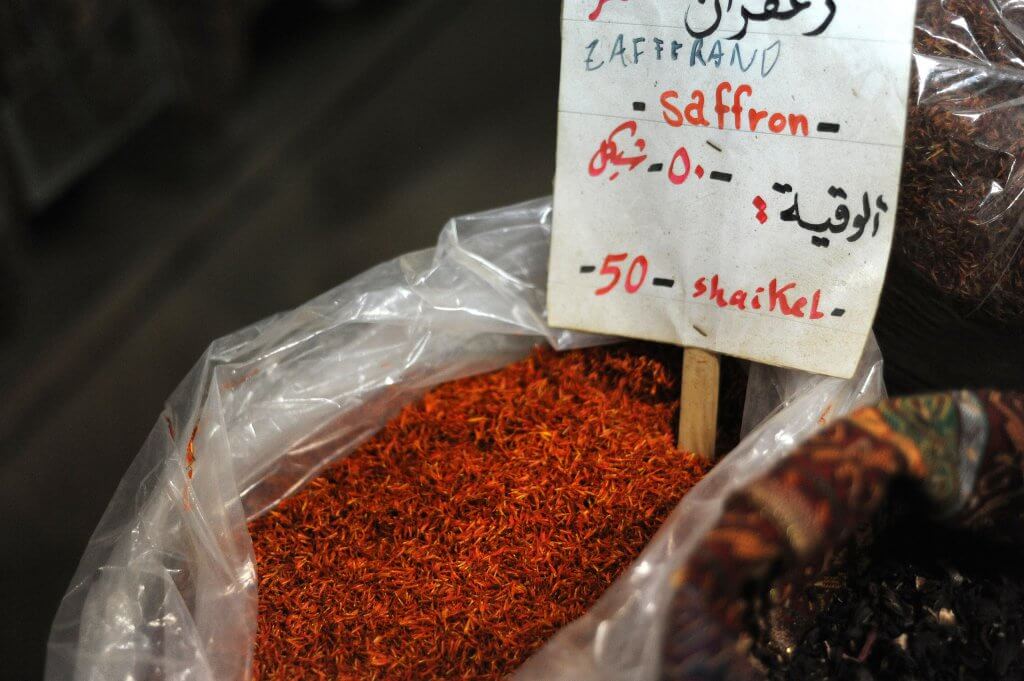Saffron is the extremely prized spice that is harvested from the saffron crocus (Crocus sativus). It has a long and varied history of trade and importance throughout the World, as well as also currently the Worlds most expensive spice by weight. One pound of saffron is currently equivalent to $500-$4000, depending on quality.
So, what exactly is Saffron?
Saffron is the collective name for the thread-like stigmas and styles collected from the saffron crocus. Each flower head produces only 3 bright red stigmas that protrude from a central orange/yellow style. The stigma and style are the female reproductive parts of the flower. These appear when the flower blooms in autumn, usually late September to mid-October. Astoundingly, it can take up to 75,000 plants to produce a pound of saffron.

Plant Characteristics
The saffron crocus is a beautiful flower within its own right. Add the value of its stigmas and the whole plant becomes valued for beauty and financial worth. The species of crocus that produces saffron is actually sterile, meaning it cannot sexually reproduce new plants by pollination and viable seeds. Because of this, cultivation methods involve dividing the new crocus corms that form and replanting them. Each corm will multiply and flower for up to 4 years, before withering.
Like all other crocuses, the saffron crocus grows from a small corm and is a perennial plant. Throughout the spring and summer, thin blade like leaves protrude from the base, followed by bracts that protect the developing flower bud. Whilst the bud develops, its true leaves will begin to sprout, before the flower heads begin opening in autumn. The petal colors range from pale pastel pinks and purples to deep mauve hues, often with striated patterning too. At full maturity the plant is usually 25cm in height, and can bear up to 4 sweet smelling flowers.
Where does saffron grow?
The saffron crocus is thought to be native to Southwest Asia, and studies have determined it may also have descended from a species pf crocus native to the Greek island of Crete. In the wild, crocuses would usually be found in arid scrubland, alpine tundra and woodlands. However as a mutated variety, it is unlikely that you will find saffron crocuses in the wild.
Today the saffron crocus can be seen in vast cultivated fields, with the biggest grower and exporter in the World being Iran. Mediterranean farmers are the second biggest producers of saffron. It needs full sun throughout the day to thrive, so south facing slopes are usually optimal.
Harvesting
One of the ultimate factors that determines the value of saffron is the labour that goes in to harvesting the tiny, delicate threads. The low yield from each plant, and the delicate collection of each stigma means labourers must be skilled and quick at their work. Usually the saffron is harvested in the morning, as the flowers begin to open and bloom.

Cautions
Doses found within most medicines and foods are generally considered safe. However over-consumption of saffron can negatively effective some people. Because of its potential ability to promote menstrual cramps, pregnant women should avoid large quantities of saffron as it could cause contractions. Those suffering from bi-polar disorder, heart conditions or low blood pressure should consult a doctor before attempting to take saffron medicinally.
Only the saffron crocus (Crocus sativus) should be used to harvest saffron threads. A poisonous lookalike known by the names of meadow saffron and autumn crocus (Colchicum autumnale) exists. As saffron crocuses often go by the name autumn crocus, care should be taken not to confuse the two plants.
Uses: Past and Present
Saffron is a varied plant part that has been used in a multitude of ways. From flavoring food and drink, scenting perfumes and creating herbal medicines and remedies.
In food
Saffron is most frequently used across the World as a spice and flavoring. Asian, European and North African cuisine, particularly many popular Moroccan and Spanish dishes, use the threads to flavor rice and meat. Its lightly sweet, earthy taste has been incorporated into a range of dishes, from curries and paella to cheeses and candies.

Medicinal
From suppressing anxious or depressive thoughts, increasing libido to treating internal bleeding. Saffron was used for a variety of ailments across cultures and through the ages. During the time of the Black Death, demand for the spice rose sharply as it was believed to be a cure. Famously, Cleopatra was known to have bathed in milk baths infused with a cup of saffron before she met with suitors. From baths, poultices or an infusion of dried saffron in a healing tea, it had many uses and applications.
Today it is still valued as a healing herb. Many people still use it to treat anxiety, PMS symptoms and enhance memory and eyesight. Although full of anti-oxidants and other beneficial compounds, its healing abilities are not particularly backed by science.

Other
The bright red coloring of saffron was often used to color fabric for clothing created for noble figures within India and China. Buddhist monks traditionally wore robes dyed with saffron. Romans also used saffron within the creation of perfumes for the hair and body and even pubic spaces.
Similar Plants, Substitutes and Imitations
Because of its value, saffron has been mis-sold and tampered with throughout the ages, as farmers and individuals seek to increase the worth of their crop or create imitation products. From soaking the threads in honey to increase their weight, to coloring pomegranate or silk fibers of a similar texture and mixing a small of amount of saffron. These were all common tricks that are used even to this day.
Safflower and turmeric were a common substitute for saffron for those who couldn’t afford the luxury spice. Both gave culinary dishes a bright yellow/orange hue, but they could not replicate the deep flavoring that saffron provided. Dried safflowers produced a higher yield of product, and were the most commonly used saffron substitute.
Current Cultural Significance
Today saffron still holds great cultural significance within parts of Asia. Due to its expensive farming methods it is still considered a luxurious spice and a sign of status. After the middle ages, saffron cultivation began to decline as other higher yielding spices became popular and more easily available. But saffron has always retained its significance as a spice of luxury.

Conclusion
A long history stretching back over 3500 years to ancient times, Saffron has always been valued as a spice of wealth and healing. Its extensive history, delicate farming methods, and cost each contributing to the luxurious culture that still surrounds the spice today. It’s deep potent flavoring can be coaxed out of even a pinch of the delicate threads. So with todays expert cultivation methods, and widespread availability, not only the wealthy benefit from its fragrant appeal. It is a common and remarkable sight in Asian spice markets, where it sits among other great piles of spices, enticing the senses.
—————Written by Hannah Sweet
Hannah is a freelance writer and graphic designer from the UK. With a penchant for travelling, photography and all things botanical, she enjoys writing about a wealth of topics and issues, from conservation and slow living, to design and travel. Learn more about her writing and design services at www.sweetmeanders.co
Many of our readers find that subscribing to Eat The Planet is the best way to make sure they don't miss any of our valuable information about wild edibles.
See our privacy policy for more information about ads on this site






